After eight long months of planning, deliberation and anticipation, Weinberg third-year Maggie Carlson walked up to the mirror in a private, plant-filled tattoo studio in Wicker Park to see her finished design for the first time. A king cobra coiled around a bundle of lilies of the valley stared back at her from its new permanent home on her ribs. Carlson was awestruck.

The marked-up stencil of Maggie Carlson’s tattoo design, a unique interpretation of a Medusa tattoo. (Photo courtesy of Maggie Carlson)
“Once it was done, it felt like a part of me, like it belonged there,” she says.
The lead-up to that moment was a long journey. In July 2021, Carlson started the search for her ideal tattoo artist in Chicago. It wasn’t until November that she stumbled upon The Same Scorpio, an independent hand-poke artist with a delicate, intricate style. She set up a meeting, paid a $150 down payment for the tattoo and met with the artist on Zoom twice to discuss the design concept before she finally stepped foot in the studio in March 2022. Still, the process was not complete: Carlson had to make the 40-minute drive into Chicago and back every other week for three two-hour long tattoo sessions.
Getting a tattoo in the Chicago area can be a daunting experience for Northwestern students — from researching artists to deciding on placement and designs to saving up to cover the costs. But Carlson says it was all worth it when standing in front of that mirror.
“From the second I saw it, any doubts wavering in the back of my head just completely vanished,” she says.
From Idea to ArtThe first obstacle for many is figuring out what symbol or artwork they want to permanently emblazon on their bodies. Tattoo inspiration can come from almost anywhere: social media, family members, memorable trips or experiences, even an inside joke. Spontaneous flash tattoos –– a pre-designed image ready for inking on demand –– or random doodles may appeal to some, but others want designs that represent something meaningful to them. Carlson is one of those people. She envisioned her snake and flower tattoo as her own personal version of a Medusa tattoo — a design commonly used to symbolize protection and one’s recovery from assault. Carlson was assaulted at the beginning of her first year at Northwestern, and getting her tattoo helped with her recovery process.
“This was part of my healing to help me reclaim my body and be like, ‘It’s mine and not somebody else’s to use,’” she says. “Anytime I feel like I’m not strong enough, I’m not doing well, it helps to look at that and know I can get through things.”
Illustrative tattoo artist Iz Mozer inks many Northwestern students at their studio in an art collective in West Town. One rewarding part of their job is seeing the impact that getting a meaningful tattoo has on their clients.
“To aid in someone’s own empowerment and liberation is such a beautiful and touching thing,” Mozer says.
“This was part of my healing to help me reclaim my body."
Weinberg third-year Maggie Carlson
Medill fourth-year Grace Deng felt that impact when Mozer tattooed her last October. Mozer inked a pill bottle with lavender growing out of it on Deng’s left bicep. The design symbolizes the combined use of holistic and Western medicine to find relief from symptoms of chronic illness — something both Mozer and Deng deal with. When choosing a tattoo artist, Deng prioritizes people with shared life experiences and identities.
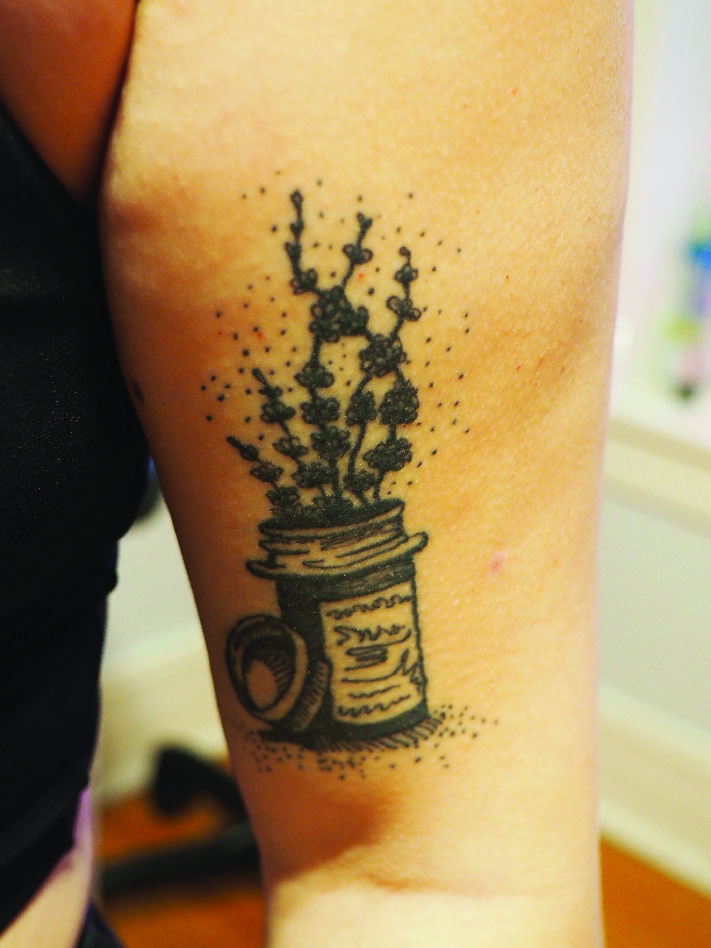
One of Deng’s tattoos from illustrative tattoo artist Iz Mozer, depicting lavender growing out of a pill bottle. (Photo by Hope Cartwright)
After months of searching for a female-identifying or non-binary Asian tattoo artist in Chicago, Deng met Adele Tamae at a pop-up art show. Tamae, a queer, Asian American and femme-identifying artist, gave Deng her fifth tattoo on May 8. The design was a six-inch portrait stretching across Deng’s right upper arm of Jobu Tupaki from Everything Everywhere All at Once.
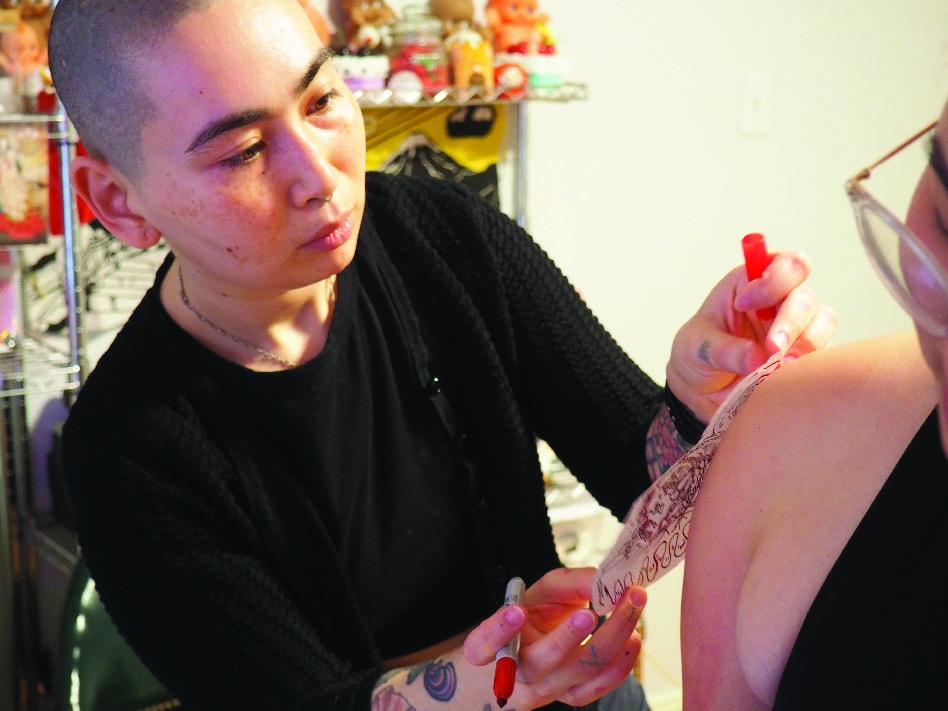
Tattoo artist Adele Tamae places the stencil for Grace Deng’s tattoo on her arm. (Photo by Hope Cartwright)
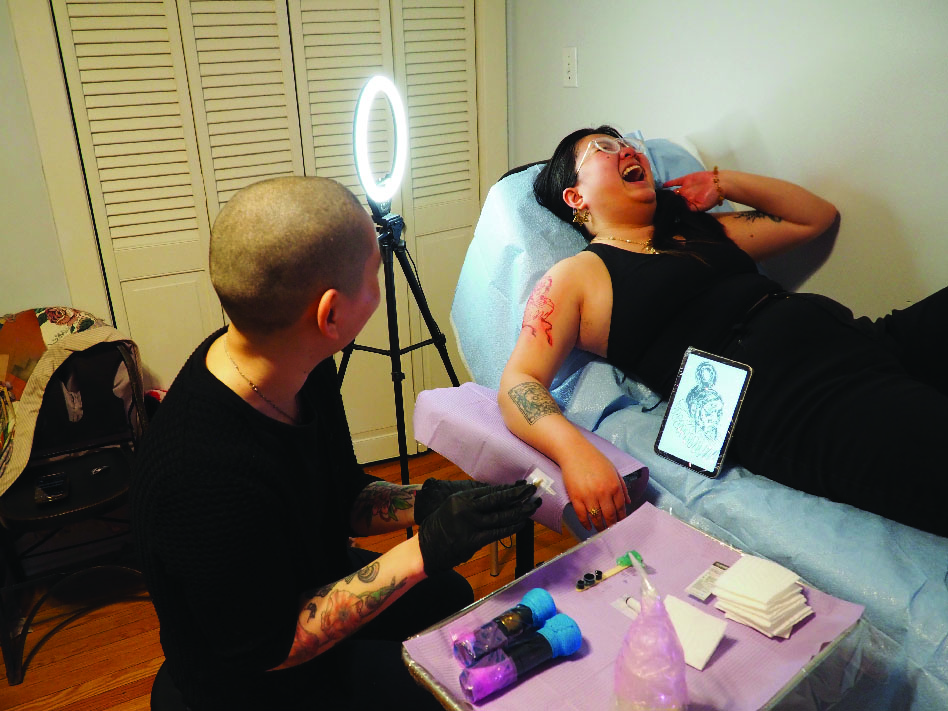
Deng laughs with Tamae during the tattoo session. (Photo by Hope Cartwright)
“[The film] is universal in a lot of ways in that search for love, but also it was very personal to me,” Deng says.
While choosing a meaningful design is important to some like Carlson and Deng, others find the selection process almost instinctive. Weinberg second-year Ethan Roe was walking through Boystown with a friend last summer when they came across Pink Rhino Tattoo on North Halsted Street. They impulsively decided to walk inside with the intention of coming out with a new piercing or flash tattoo.
As Roe’s friend got a helix piercing, they looked through each Pink Rhino artist’s flash collections. One design stood out to Roe: a lighter with a plant growing where there should be a flame. Though the artist who designed it wasn’t there that day, Roe came back later that same week to get it tattooed. Roe wants tattoos, and getting flash is a fast and easy way to build a collection of art on their body.
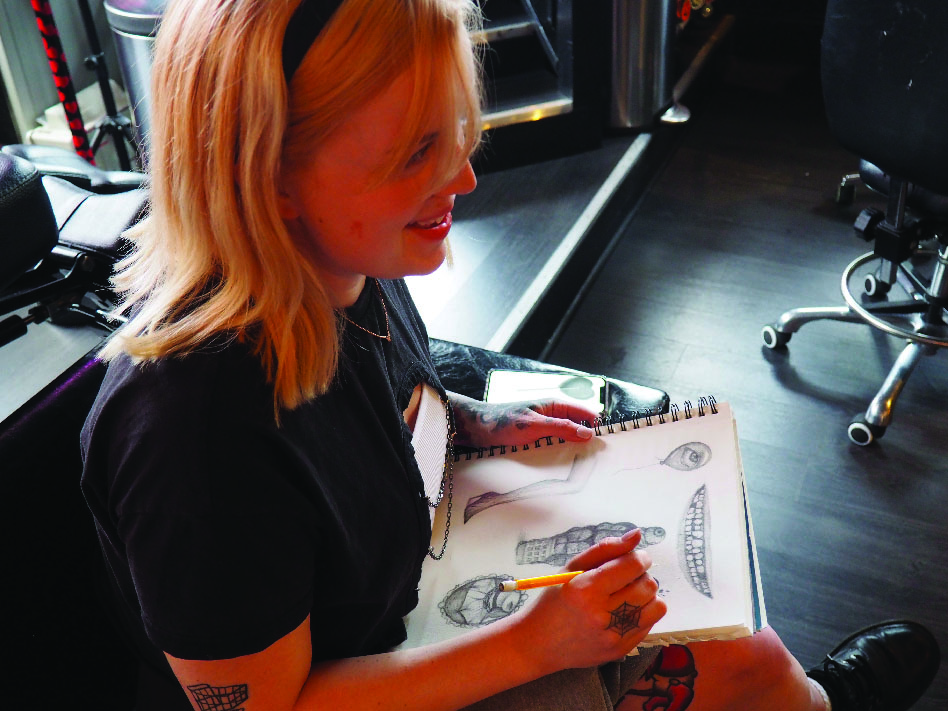
Bly Logan, tattoo artist at Pink Rhino, sketches potential designs in her notebook. (Photo by Hope Cartwright)
“There’s not a strict criteria,” Roe says. “If I vibe with it, I vibe with it.”
Mozer finds that tattoos people get for the aesthetic are often just as impactful as ones with personal stories behind them.
“I don’t think there’s a wrong intention for a tattoo,” Mozer says.
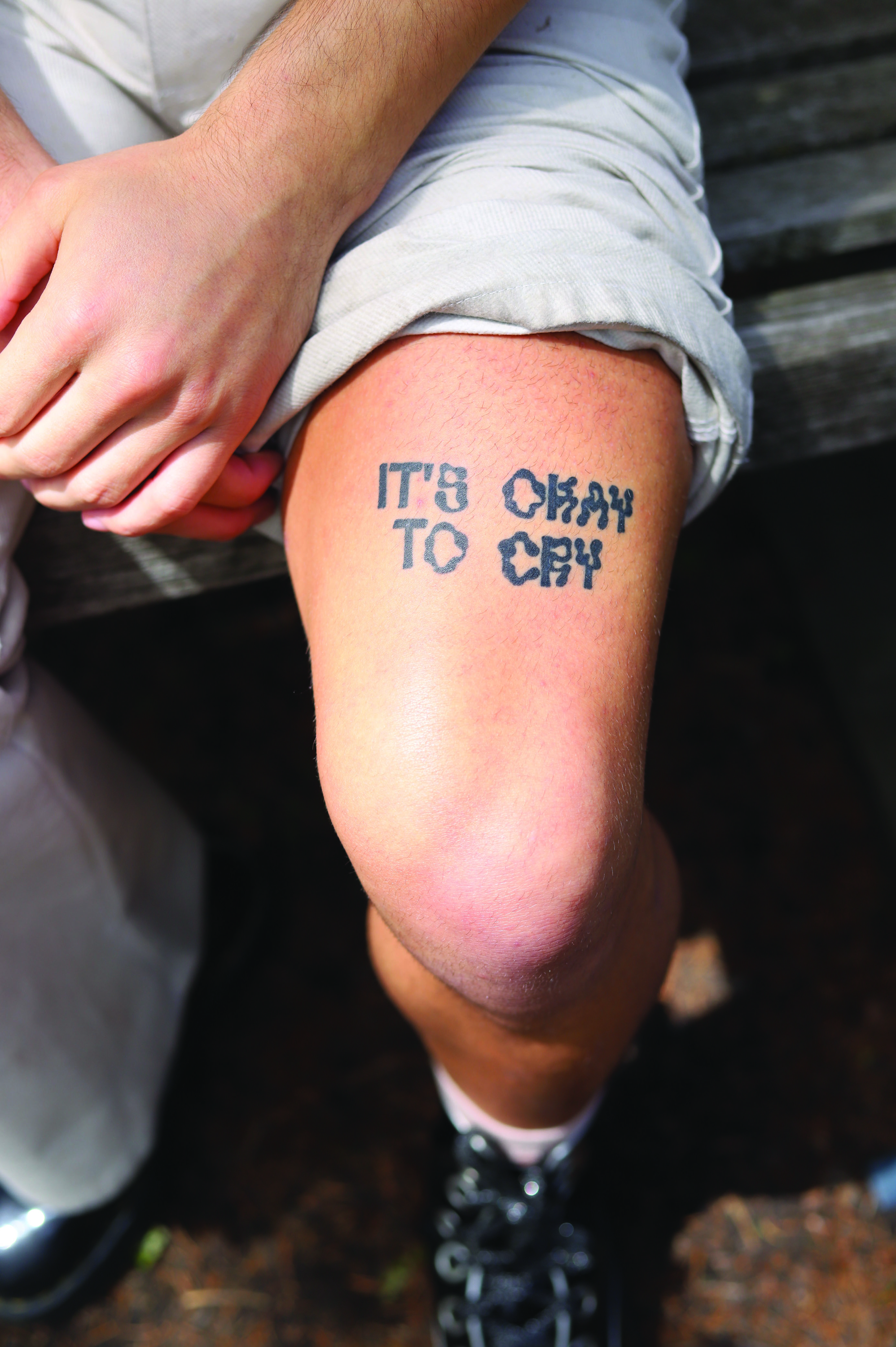
Ethan Roe’s tattoo from Pink Rhino reads, “It’s Okay To Cry,” the name of a song by their favorite artist SOPHIE. (Photo by Eloise Apple)
At Pink Rhino Tattoo, where Roe has been tattooed twice, owner and tattoo artist David Herrera sums up the pricing as “it depends.” The size, placement and complexity of the design all factor into the cost, so a client won’t know the definite price until they talk to the artist. Pink Rhino’s minimum price for a tattoo is $100, covering something from the size of a dot to a dime.

Pink Rhino Tattoo shop owner David Herrera leans on the doorway into the tattooing area. (Photo by Hope Cartwright)
Once a tattoo design is decided, the logistical obstacles follow. First, there’s the price.
Carlson paid $700 for her fine line, hand-poked tattoo. The cost included the $150 downpayment Carlson paid before the Zoom consultations started. Luckily for Carlson, a few months earlier in December 2021, a couple left her a $1,000 tip at her server job at Found Kitchen in Evanston. With this boost in income, as well as her other tips from working 25 to 30 hours a week and cutting back on eating out, Carlson was able to meet living costs and set aside enough money for the tattoo. Considering the level of care and thought her artist put into the design, Carlson felt the price was reasonable.
Deng paid $225 plus tip for her Jobu Tupaki tattoo from Tamae, an independent artist. Price is something Deng considers before scheduling future appointments. She’s wanted a large thigh tattoo of Chang’e, the Chinese moon goddess, for a long time but is saving up as she expects the price to be $1,000 or more.
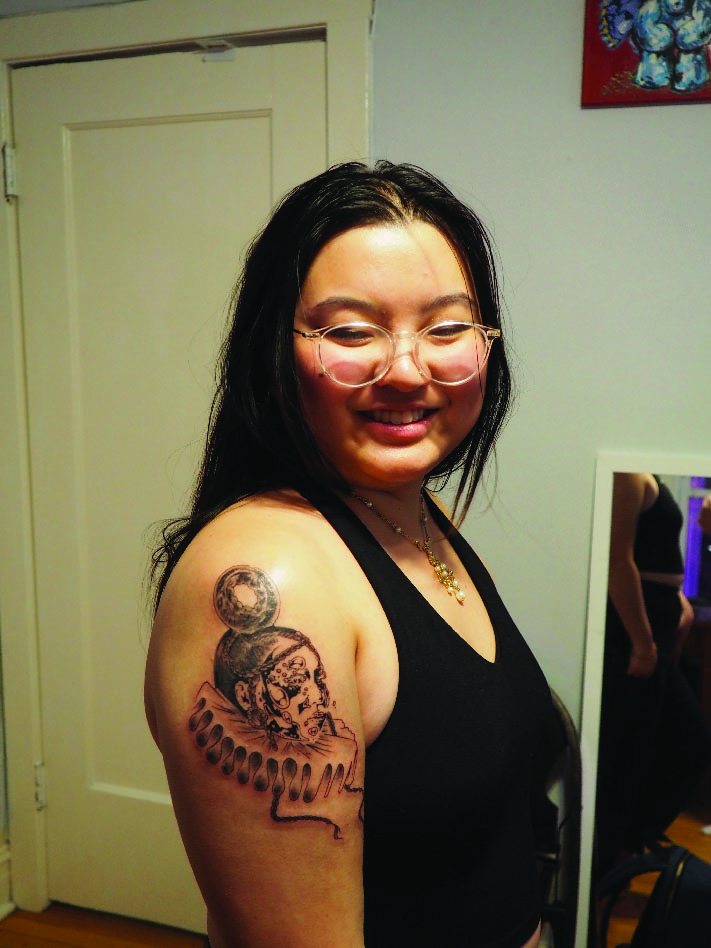
Deng smiles at her completed portrait tattoo minutes after Tamae set down her machine. (Photo by Hope Cartwright)
In addition to the cost, the anticipation of pain can also deter students from getting a tattoo, especially their first one.
“Most people come in, they’re usually intimidated,” Mozer says. “I affirm and try to be there for clients reminding them that limits are important and that pain is okay to experience.”
After five tattoos, Roe feels confident that the temporary pain of getting a tattoo is worth it considering its permanence.
“It’s a very mild investment compared to what you’re getting out of that,” Roe says, adding that the pain isn’t as bad as one might expect. “It feels like a bee sting turned 10 notches down.”
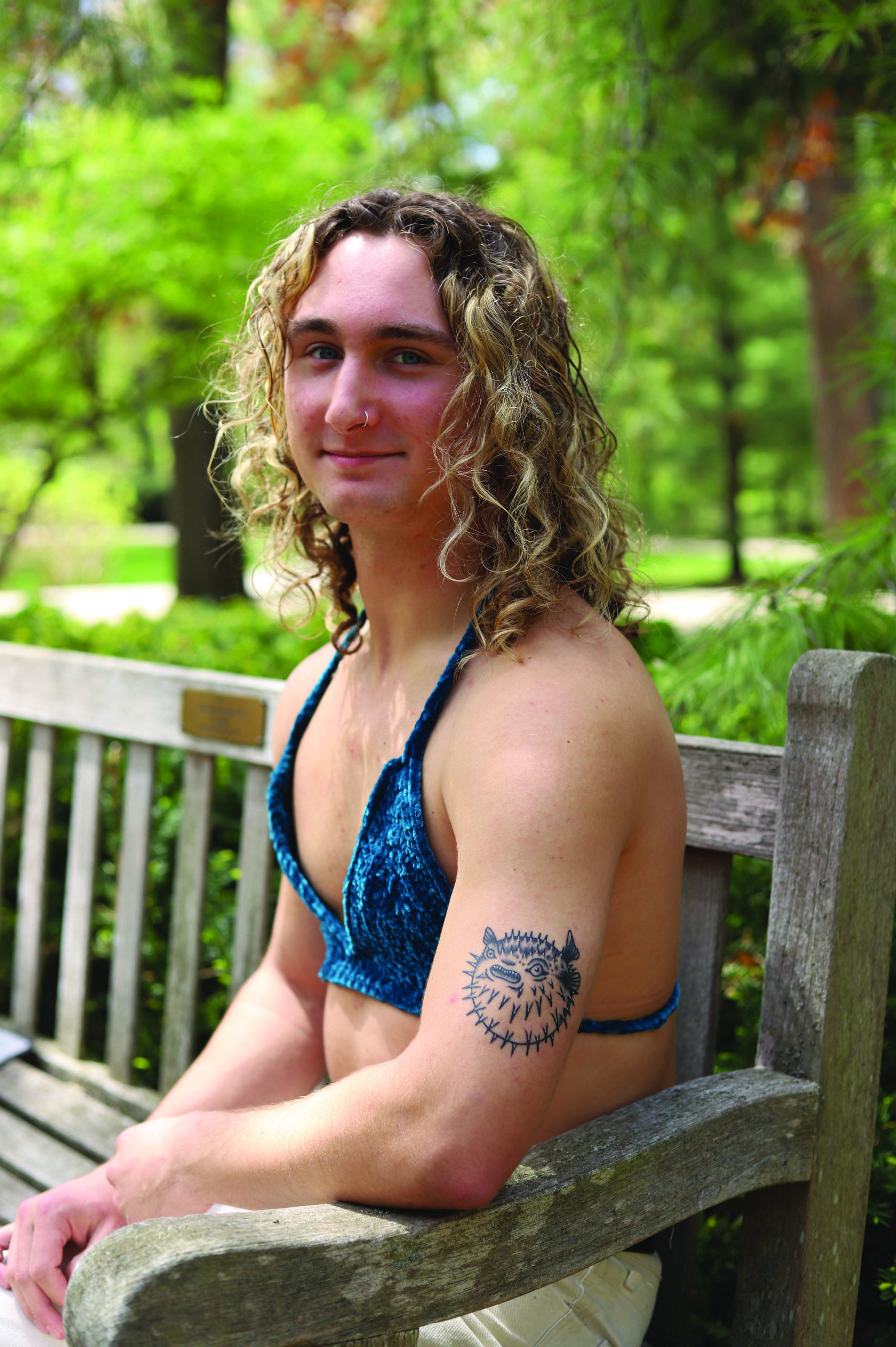
Roe shows off their most recent tattoo, a flash design of a puffer fish. (Photo by Eloise Apple)
While Tamae worked on Deng’s newest tattoo in a six-hour long session, Deng mentioned frequently that she felt relaxed.
“You’re very gentle,” Deng told her artist. The chill music and persistent hum of the tattoo machine made for a soothing environment. Deng only complained of pain when Tamae’s machine got closer to her shoulder but maintained that the pain was worth it.
As an artist, Mozer feels it’s important to listen to the clients and respond to their pain and other concerns. They think the biggest red flag in a tattoo artist is someone pressuring clients into something they’re not ready for.
“If you have specifications about size and placement and how your body is treated, don’t take less than what you deserve,” Mozer says. “You can revoke your consent at any point.”
Herrera emphasizes that a client can always ask about health and safety standards. Every official body art establishment in Chicago must meet requirements set by the Illinois Department of Public Health. At Pink Rhino, every needle and cartridge is sterilized and single-use. Herrera is hopeful that every shop is the same.
“It’s okay to ask the artist,” he says. “A lot of people, I think, are afraid to ask their artist. Just for their peace of mind, we use everything disposable.”
Looking in the MirrorDespite the hurdles they have to cross, students leave tattoo parlors with art they’ll have with them for the rest of their lives. For many, it’s a big step in self-love. When Roe peels the clear bandage off their newly inked skin each time they’re tattooed, they can’t help but proudly stare in the mirror.
“It is so exciting to see [yourself] exerting control over what your body looks like, and it’s a really direct way to do that,” Roe says.
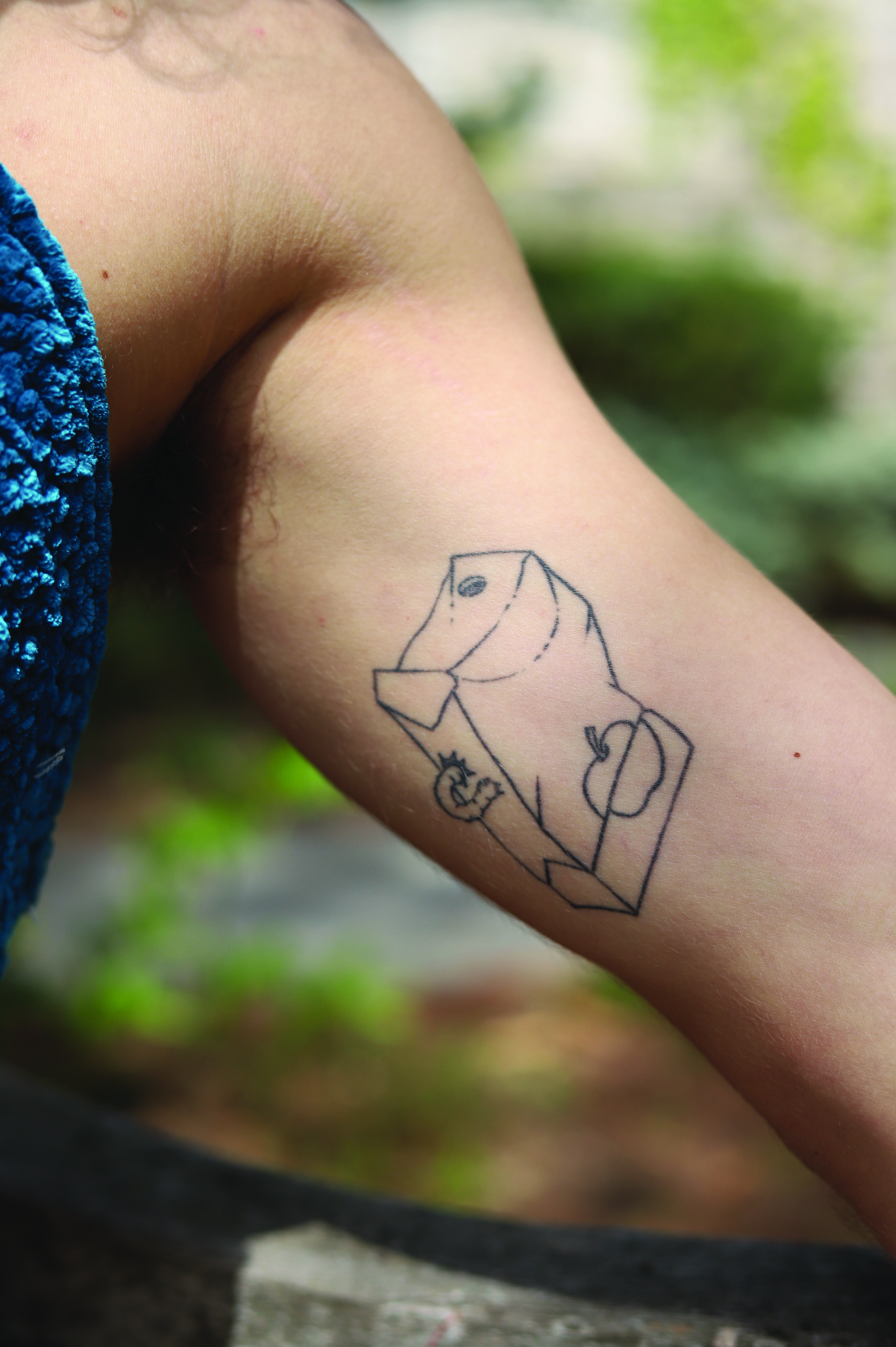
Roe’s first Chicago-area tattoo, which they got last year at the shop Tattoo Union in Chinatown. (Photo by Eloise Apple)
Even unplanned tattoos have their beauty.
“So many of my friends have impulsively gotten tattoos that they love that have no meaning to them but just look really cool,” Deng says. “I think there’s something beautiful about adorning your body with art impulsively.”
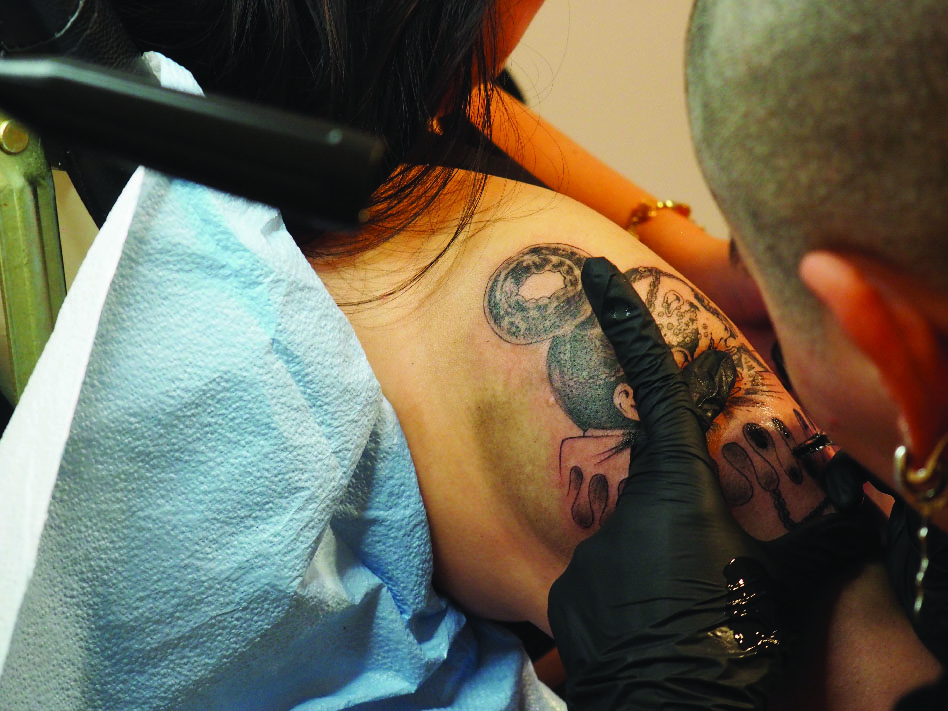
Tamae adds the finishing touches to Deng’s tattoo of Jobu Tupaki. (Photo by Hope Cartwright)
No matter the size or price of a tattoo, the impact is permanent. Leaving The Same Scorpio’s tattoo studio last year, Carlson felt stronger than before.
“It really helped me feel like my body was my own,” she says. “Having that as something that was uniquely me really helped with feeling strong again and feeling like my body is mine.”